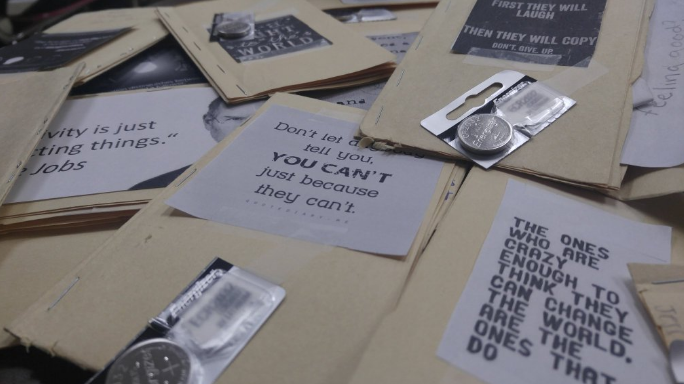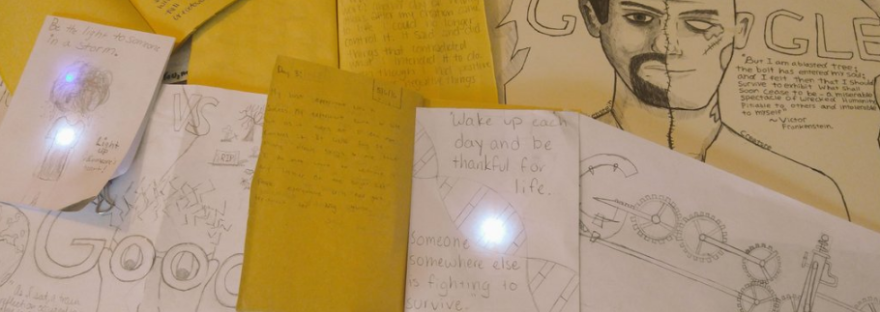As I look back on my first year of teaching, I have so many regrets. I am sure all first-year teachers feel this way, but my regrets are probably shared by even the most veteran teachers. The constant negotiation between expectations placed on teachers vs what it actually means to teach our digital natives, future innovators, makers, hackers and whatever latest educational buzzwords float in the atmosphere.
With this being said, I eagerly counted down the days till the end of the year. I was exhausted and only needed to survive 4 more weeks. I was frustrated and not with my students. Sure, they were engaged. I saw drastic improvements in their content based skill sets. This wasn’t enough. My students, your students, all students- are captains of knowledge curation….and creation. What I mean by this is- their abilities extend what we can even begin to imagine. What had I taught them? Certainly not what they were capable of. They were another set of ELA content savvy reading and writing machines.
 After a year of throwing my lessons to the side and following the safe first-year teacher path…I was ready to take the risk. It was in those 4 weeks, I really saw my students. What if I had done this for the whole year? It is for this reason, I wanted to share my assessment/ materials. I found it difficult to locate ELA lessons that integrated making with standards and content. Feel free to use or modify anything!
After a year of throwing my lessons to the side and following the safe first-year teacher path…I was ready to take the risk. It was in those 4 weeks, I really saw my students. What if I had done this for the whole year? It is for this reason, I wanted to share my assessment/ materials. I found it difficult to locate ELA lessons that integrated making with standards and content. Feel free to use or modify anything!
The Frankenstein Effect Project- or more lovingly named by my students as, “Um, this is English class”.
This assessment was designed to:
Promote a deep and meaningful 21st century understanding of “Frankenstein”. This will be accomplished in a 5 day global experiment simulation, using paper circuits as evidence of positive or negative outcomes.
This assessment was followed by a video project. I will complete a separate post about this.
Day 1
Students were given a research outline: Imagine that you have an opportunity to create something, which will impact or improve the quality of human life. What area will your creation target?
Students had to be data specific, so the number of individuals impacted was measurable (both positively and negatively).
Day 2
Students created their sketchbook, glued in their MLA citations, and used their research outline to complete pages 1-2 of their sketchbook.
Note: warm up focused on science in the time of Mary Shelley (static vs current).
Day 3 & 4:
Students were given a brief explanation of circuits, watched a chibitronics video, created a circuit each day and completed their narrative writing log. Students were given limited instructions intentionally, as this tied into Victor Frankenstein and his journey
T his was when I began to see my students’ natural curiosity. Students would add multiple watch batteries and watch their LED become brighter. Some students even compared the brightness to their cell phone flashlight. Students debated if pennies were conductive like the copper tape. The coolest moment? When a group of students realized that they could complete the circuit by holding hands- independently.
his was when I began to see my students’ natural curiosity. Students would add multiple watch batteries and watch their LED become brighter. Some students even compared the brightness to their cell phone flashlight. Students debated if pennies were conductive like the copper tape. The coolest moment? When a group of students realized that they could complete the circuit by holding hands- independently.
Note: Students completed a Makey Makey warm up activity on day 4.
Day 5:
Students reported to class with their finalized  sketched symbol. Students decided how they wanted to illuminate their symbol and created an appropriate circuit. Students were allowed to research other options, such as a parallel circuit and many did.
sketched symbol. Students decided how they wanted to illuminate their symbol and created an appropriate circuit. Students were allowed to research other options, such as a parallel circuit and many did.
Students the n set up their Makey Makey, opened scratch and connected to their symbol in teams of 4 using these directions. Students then witnessed their creation “come to life”. The creation would then say something negative or positive. Students, like Victor Frankenstein- could not control their creation. Students completed their final narrative log as homework.
n set up their Makey Makey, opened scratch and connected to their symbol in teams of 4 using these directions. Students then witnessed their creation “come to life”. The creation would then say something negative or positive. Students, like Victor Frankenstein- could not control their creation. Students completed their final narrative log as homework.
Some amazing things occurred in my classroom on day 5. First, teachers I had never met before were wandering in my classroom throughout the day to ask students about their project. Students would explain everything and I mean everything. They wanted to explain Victor Frankenstein, the circuits, Makey and research about their selected cause.
Second, I saw a shift in the attitude of my female students. This might be my favorite story about this unit. One of my female students had a male student troubleshoot her circuit. I asked the student why and she responded, “girls aren’t good at this stuff”. Another female student walked over and responded”I’m good at this! A lot of girls are good at this and we can make more money doing it. It’s one thing to say you aren’t good at circuits, but that doesn’t mean we all aren’t.”
Day 6
Students turned in their finished sketchbook and completed a series of reflection questions and completed their Creators Conference.

What cool ways are you using making in your class? I want to hear about your awesome classroom experiences!
A special thank you to David Cole for his contribution and support.


Reblogged this on Alaska Ed Tech.
LikeLiked by 1 person
I absolutely loved your unit, so much so that I read everything you had linked to it. Every student that is lucky enough to have you will be better off because of the creativeness and expertise you use when developing your units. I don’t teach high school english, but I wanted to read your blog to gain more insight into making. It also often helps inspire ideas for my own classroom. Thank you for sharing this great idea!
LikeLiked by 1 person
Hi Catherine,
I am so glad you enjoyed the unit and materials! I would love to hear about your class and how you are integrating/ planning to integrate making in your instruction!
LikeLike
thank you for sharing. This is great work and an inspiration to all other teachers in this field. I am curious to see your video project too.
LikeLike
Wow. I have been an educator for 30 years (had my math wrong in #akedchat earlier!) and I have much to learn from you, O 2nd Year Teaching Master!
LikeLike
This is great … thanks for sharing out.
Kevin
LikeLike